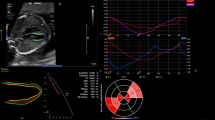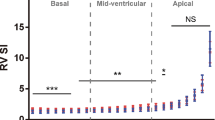Abstract
To determine reference values for fetal heart biometric parameters using the spatiotemporal image correlation (STIC) M mode and their applicability in congenital heart diseases (CHDs). A cross-sectional prospective study was conducted with 300 singleton pregnancies between 20 and 33 + 6 weeks of gestation. Right ventricular wall thickness (RVWT), interventricular septum thickness (IVST), and left ventricular wall thickness (LVWT) were measured off-line using the STIC-M mode with the cursor perpendicular to the interventricular septum. Polynomial regressions adjusted with the coefficient of determination (R 2) were performed. The curves were applied to 14 fetuses with structural CHD. For the reproducibility calculations, the concordance correlation coefficient (CCC) was used. The mean RVWT, IVST, and LVWT were 0.34 ± 0.09 cm, 0.28 ± 0.09 cm, and 0.30 ± 0.07 cm, respectively. There was correlation between RVWT, IVST, and LVWT and gestational age (GA): RVWT = −0.002 + 0.013 × GA (R 2 = 0.33), IVST = −0.011 + 0.011 × GA (R 2 = 0.25), and LVWT = 0.056 + 0.009 × GA (R 2 = 0.26). RVWT, IVST, and LVWT were altered (<5th or >95th percentile) in 5/14, 5/14, and 7/14 of the fetuses with CHD, respectively. For RVWT, IVST, and LVWT, intra-observer (CCC = 0.86, 0.85, and 0.87, respectively) and inter-observer (CCC = 0.86, 0.86, and 0.86, respectively) reproducibility were good/moderate. The reference ranges determined for fetal heart biometric parameters using STIC-M had good intra- and inter-observer reproducibility and were applicable to fetuses with CHD.




Similar content being viewed by others
References
Huhta JC (2001) Right ventricular function in the human fetus. J Perinat Med 29:381–389
Zielinsky P, Luchese S, Manica JL, Piccoli AL Jr, Nicoloso LH, Leite MF, Hagemann L, Busato A, Moraes MR (2009) Left atrial shortening fraction in fetuses with and without myocardial hypertrophy in diabetic pregnancies. Ultrasound Obstet Gynecol 33:182–187
Wacker-Gussmann A, Strasburger JF, Cuneo BF, Wakai RT (2014) Diagnosis and treatment of fetal arrhythmia. Am J Perinatol 31:617–628
Kleinman CS, Hobbins JC, Jaffe CC, Lynch DC, Talner NS (1980) Echocardiographic studies of the human fetus: prenatal diagnosis of congenital heart disease and cardiac dysrhythmias. Pediatrics 65:1059–1067
Kassem E, Humpl T, Friedberg MK (2013) Prognostic significance of 2-dimensional, M-mode, and Doppler echo indices of right ventricular function in children with pulmonary arterial hypertension. Am Heart J 165:1024–1031
Allan LD, Joseph MC, Boyd EG, Campbell S, Tynan M (1982) M mode echocardiography in the developing human fetus. Br Heart J 47:573–583
De Vore GR, Siassi B, Platt LD (1985) Use of femur length as a means of assessing M-mode ventricular dimensions during second and third trimesters of pregnancy in normal fetus. J Clin Ultrasound 13:619–625
Gonçalves LF, Lee W, Chaiworapongsa T, Espinoza J, Schoen ML, Falkensammer P, Treadwell M, Romero R (2003) Four-dimensional ultrasonography of the fetal heart with spatiotemporal image correlation. Am J Obstet Gynecol 189:1792–1802
Molina FS, Faro C, Sotiriadis A, Dagklis T, Nicolaides KH (2008) Heart stroke volume and cardiac output by four-dimensional ultrasound in normal fetuses. Ultrasound Obstet Gynecol 32:181–187
Nardozza LM, Rolo LC, Araujo Júnior E, Hatanaka AR, Rocha LA, Simioni C, Ruano R, Moron AF (2013) Reference range for fetal interventricular septum area by means of four-dimensional ultrasonography using spatiotemporal image correlation. Fetal Diagn Ther 33:110–115
Rolo LC, Rizzo G, Pietrolucci ME, Barros FS, Nardozza LM, Martins WP, Arduini D, Moron AF, Araujo Júnior E (2014) Viewing rate and reference ranges for papillary muscle areas of the fetal heart using four-dimensional ultrasound in the rendering mode. Prenat Diagn 34:1153–1160
Messing B, Gilboa Y, Lipschuetz M, Valsky DV, Cohen SM, Yagel S (2013) Fetal tricuspid annular plane systolic excursion (f-TAPSE): evaluation of fetal right heart systolic function with conventional M-mode ultrasound and spatiotemporal image correlation (STIC) M-mode. Ultrasound Obstet Gynecol 42:182–188
Luewan S, Yanase Y, Tongprasert F, Srisupundit K, Tongsong T (2011) Fetal cardiac dimensions at 14-40 weeks’ gestation obtained using cardio-STIC-M. Ultrasound Obstet Gynecol 37:416–422
International Society of Ultrasound in Obstetrics and Gynecology, Carvalho JS, Allan LD, Chaoui R, Copel JA, DeVore GR, Hecher K, Lee W, Munoz H, Paladini D, Tutschek B, Yagel S (2013) ISUOG Practice Guidelines (updated): sonographic screening examination of the fetal heart. Ultrasound Obstet Gynecol 41:348–359
Gonçalves LF, Lee W, Espinoza J, Romero R (2006) Examination of fetal heart by four-dimensional (4D) ultrasound with spatio-temporal image correlation (STIC). Ultrasound Obstet Gynecol 27:336–348
Altman DG, Chitty LS (1994) Charts of fetal size I: methodology. Br J Obstet Gynaecol 101:29–34
Martins WP, Nastri CO (2014) Interpreting reproducibility results for ultrasound measurements. Ultrasound Obstet Gynecol 43:479–480
Cooper MJ, Enderlein MA, Tarnoff H, Rogé CL (1992) Asymmetric septal hypertrophy in infants of diabetic mothers. Fetal echocardiography and the impact of maternal diabetic control. Am J Dis Child 146:226–229
Fouda UM, Abou ElKassem MM, Hefny SM, Fouda RM, Hashem AT (2013) Role of fetal echocardiography in the evaluation of structure and function of fetal heart in diabetic pregnancies. J Matern Fetal Neonatal Med 26:571–575
Balli S, Pac FA, Ece İ, Oflaz MB, Kibar AE, Kandemir Ö (2014) Assessment of cardiac functions in fetuses of gestational diabetic mothers. Pediatr Cardiol 35:30–37
DeVore GR (2005) Assessing fetal cardiac ventricular function. Semin Fetal Neonatal Med 10:515–541
Viñals F, Mandujano L, Vargas G, Giuliano A (2005) Prenatal diagnosis of congenital heart disease using four-dimensional spatio-temporal image correlation (STIC) telemedicine via an Internet link: a pilot study. Ultrasound Obstet Gynecol 25:25–31
Tongsong T, Wanapirak C, Piyamongkol W, Sirichotiyakul S, Tongprasert F, Srisupundit K, Luewan S (2011) Fetal ventricular shortening fraction in hydrops fetalis. Obstet Gynecol 117:84–91
Messing B, Gilboa Y, Lipschuetz M, Valsky DV, Cohen SM, Yagel S (2013) Fetal tricuspid annular plane systolic excursion (f-TAPSE): evaluation of fetal right heart systolic function with conventional M-mode ultrasound and spatiotemporal image correlation (STIC) M-mode. Ultrasound Obstet Gynecol 42:182–188
Maeno Y, Hirose A, Kanbe T, Hori D (2009) Fetal arrhythmia: prenatal diagnosis and perinatal management. J Obstet Gynaecol Res 35:623–629
Salih M, Demirel LC, Kurtay G (1998) Prenatal diagnosis of ostium secundum atrial septal defect by M-mode fetal echocardiography. Gynecol Obstet Invest 45:68–70
Simpson JM, Cook A (2002) Repeatability of echocardiographic measurements in the human fetus. Ultrasound Obstet Gynecol 20:332–339
Compliance with Ethical Standards
Conflict of interest
All authors declare they have no conflicts of interest.
Author information
Authors and Affiliations
Corresponding author
Rights and permissions
About this article
Cite this article
Tedesco, G.D., de Souza Bezerra, M., Barros, F.S.B. et al. Reference Ranges of Fetal Cardiac Biometric Parameters Using Three-Dimensional Ultrasound with Spatiotemporal Image Correlation M Mode and Their Applicability in Congenital Heart Diseases. Pediatr Cardiol 38, 271–279 (2017). https://doi.org/10.1007/s00246-016-1509-1
Received:
Accepted:
Published:
Issue Date:
DOI: https://doi.org/10.1007/s00246-016-1509-1




